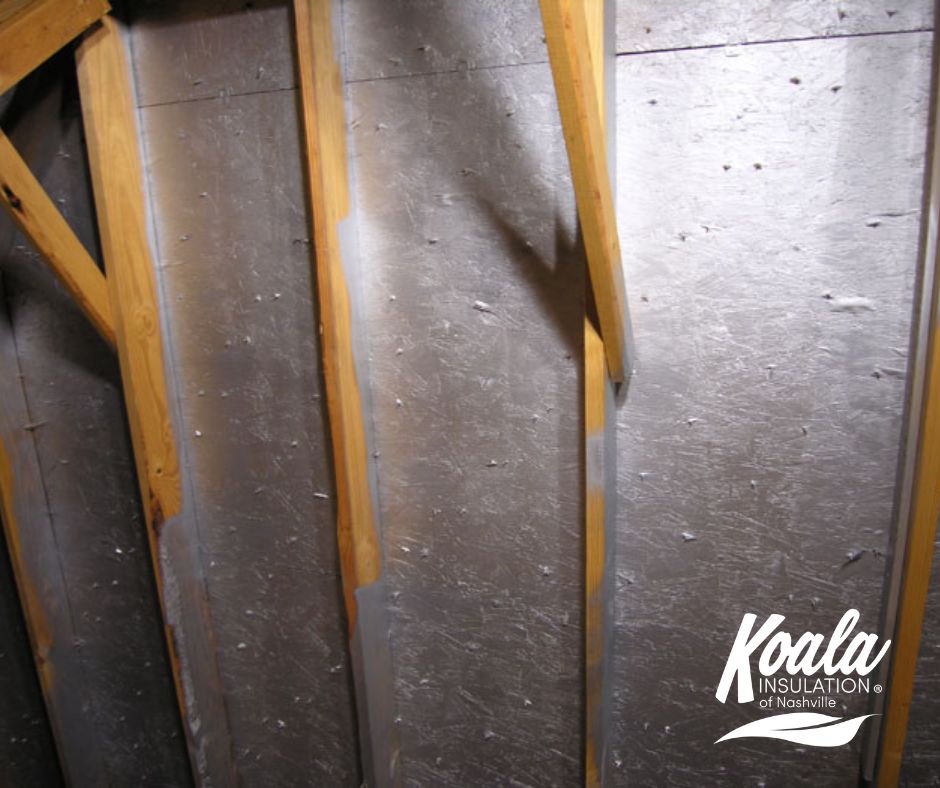
Radiant Barrier
Radiant Barriers
Radiant barriers are used in homes to lower summer heat gain, increase the efficiency of cooling units, and reduce cooling costs. They are commonly installed in attics. Radiant barriers are made of a highly reflective substance that avoids heat absorption.
How Do Radiant Barriers Work?
A combination of conduction, convection, and radiation transports heat from a warm to a cold region.
Just like how a spoon in a hot cup of coffee conducts heat via its handle to your hand, heat is transferred by conduction from a hotter to a colder point inside a material or assembly,
Convection heat transfer happens when a liquid or gas, such as air, is heated, becomes less dense, and rises. The liquid or gas grows denser and comes down as it cools.
Radiant heat radiates in a straight direction away from any surface, heating anything solid that receives it. Most insulating materials work by slowing convective and conductive heat movement.
Reflective insulation and radiant barriers operate by minimizing radiant heat gain. The reflecting surface needs to face an air space to get the best results. The reflecting surface's potential to reflect will diminish if dust builds up it. The radiant barrier should be built in such a way that dust does not compile on the reflecting surface.
When the roof gets heated by the sun, the radiant energy of the sun serves as the primary source of heat. Then most of the heat is transported to the attic side of the roof by conduction through the roofing materials. The heated roof material then distributes the heat energy it has collected onto the colder attic surfaces, such as the air ducts and attic floor. The radiant heat transmission from the bottom of the roof to the other surfaces in the attic is reduced by a radiant barrier.
What’s more, when a radiant barrier is perpendicular to the radiant energy affecting it, it functions more effectively. In addition, the more the difference in temperature between the surfaces of the radiant barrier material, the more benefits it may provide.
Additionally, radiant barriers are more effective in hot regions than in cold ones. This is even better when there are cooling air ducts in the attic. According to some research, radiant barriers can cut cooling costs by 5% to 10% when employed in a warm, sunny region.
What are the Types of Radiant Barriers?
Radiant barriers are made out of a highly reflective substance, generally, aluminum foil, that is put to one or both sides of kraft paper, plastic films, cardboard, oriented strand board, and air infiltration barrier material.
There are Fiber reinforcement products that are used in several items to improve durability and handling. In reflective insulation systems, radiant barriers can be integrated with a variety of insulating materials. Radiant barriers can be used as the face material for thermal insulation in certain situations.
How Radiant Barriers Are Installed
Radiant barriers are simpler to install in a new home, but they can also be installed in an existing home. For this reason, we opt to use a product call Heat Bloc Ultra. It is a spray on radiant barrier and is installed similarly to painting. We cover the roof decking and this product is just as effective if not more since it's easier to ensure uniformity and complete coverage.
Since the efficiency of a radiant barrier is dependent on proper installation, it's preferable to use a professional. If you decide to install it by yourself, ensure you read the manufacturer's instructions and safety precautions carefully. Also, know your local building and fire laws.
For a new building, the installer will hang a rolled-foil radiant barrier foil-face down between the roof rafters to prevent dust from gathering on the reflective surfaces. This is usually done right before the roof sheathing is installed, although it can also be done later from inside the attic by stapling the material to the rafters' bottoms. For the foil type barrier, it's best to allow an air gap of 2.5cm by allowing the material to "droop" between the attachment points. You should avoid making contact with exposed electrical wire because reflective foil conducts electricity.
Lastly, avoid installing a radiant barrier directly on top of the attic floor insulation since the foil will be sensitive to dust collection and may trap moisture in fiber insulation. A radiant barrier also needs an air gap below it to be effective. We saw a home in Franklin, TN and another one in Brentwood that had foil laid right on top of their insulation. This is a total waste and completely inneffective.
Contact Us Today!
Koala Insulation offers professional home insulation services. Contact us to learn more about your options. We are proud to serve clients across Brentwood, Bellevue, Franklin, Old Hickory, East Nashville, Madison, Nolensville, and other Nashville areas.
Ready to book your free insulation evaluation?
We have 3 convienant ways for you to get in touch
We Provide Insulation Services to the Following Nashville Areas
Hermitage, Madison, Mount Juliet, Old Hickory, Nashville, Whites Creek, Lascassas, Murfreesboro, Rockvale, Antioch, La Vergne, Nolensville, Smyrna, Arrington, Brentwood, College Grove, Eagleville, Franklin, Thompsons Station
Counties Served
Davidson County, Wilson County, Rutherford County, Williamson County
Zip Code
37085, 37127, 37128, 37129, 37130, 37153, 37204, 37205, 37211, 37215, 37217, 37220, 37221, 37189, 37201, 37203, 37206, 37207, 37208, 37209, 37210, 37212, 37213, 37218, 37219, 37228, 37232, 37234, 37240, 37243, 37246, 37076, 37115, 37122, 37138, 37214, 37216, 37014, 37027, 37046, 37060, 37064, 37067, 37069, 37179, 37013, 37086, 37089, 37135, 37167

